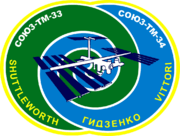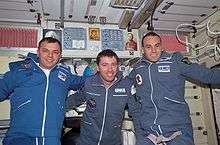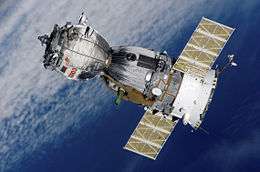Soyuz TM-34
| Operator | Rosaviakosmos | ||||
|---|---|---|---|---|---|
| COSPAR ID | 2002-020A | ||||
| Mission duration | 198 days, 17 hours, 37 minutes, 45 seconds | ||||
| Orbits completed | ~3,235 | ||||
| Spacecraft properties | |||||
| Spacecraft type | Soyuz-TM | ||||
| Manufacturer | RKK Energia | ||||
| Crew | |||||
| Crew size | 3 | ||||
| Launching |
Yuri Gidzenko Roberto Vittori Mark Shuttleworth | ||||
| Landing |
Sergei Zalyotin Frank De Winne Yury Lonchakov | ||||
| Callsign | Uran | ||||
| Start of mission | |||||
| Launch date | April 25, 2002, 06:26:35 UTC | ||||
| Rocket | Soyuz-U | ||||
| End of mission | |||||
| Landing date | November 10, 2002, 00:04:20 UTC | ||||
| Landing site | 80 kilometres (50 mi) NE of Arkalyk | ||||
| Orbital parameters | |||||
| Reference system | Geocentric | ||||
| Regime | Low Earth | ||||
| Perigee | 193 kilometres (120 mi) | ||||
| Apogee | 247 kilometres (153 mi) | ||||
| Inclination | 51.6 degrees | ||||
| Period | 88.6 minutes | ||||
| Docking with ISS | |||||
 
| |||||
Soyuz TM-34 was the fourth Soyuz mission to the International Space Station (ISS).[1] Soyuz TM-34 was launched by a Soyuz-U launch vehicle.
Crew
| Position | Launching crew | Landing crew |
|---|---|---|
| Commander | Third and last spaceflight |
Second and last spaceflight |
| Flight Engineer | First spaceflight |
First spaceflight |
| Spaceflight Participant/Flight Engineer | First spaceflight Tourist |
Second spaceflight |
Docking with ISS
- Docked to ISS: April 27, 2002, 07:55 UTC (to nadir port of Zarya)
- Undocked from ISS: November 9, 2002, 20:44 UTC (from nadir port of Zarya)
Mission highlights
This was the 17th manned mission to ISS.
Soyuz TM-34 was a Russian Soyuz TM passenger transportation craft that was launched by a Soyuz-U rocket from Baikonur at 06:26 UT on 25 April 2002. It carried two cosmonauts and a South African tourist, Mark Shuttleworth, to the International Space Station (ISS). Shuttleworth performed some biology experiments, as he carried a live rat and sheep stem cells. All three returned on Soyuz TM-33 after an eight-day mission.
Soyuz TM-34 was the final flight of the Soyuz-TM variant, due to its replacement by the upgraded Soyuz-TMA.[1]
References
- 1 2 "Soyuz ISS Missions" (PDF). NASA.
This article is issued from Wikipedia - version of the 5/25/2016. The text is available under the Creative Commons Attribution/Share Alike but additional terms may apply for the media files.

